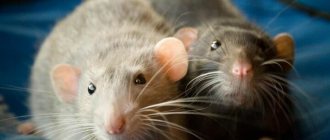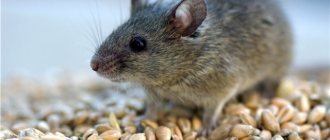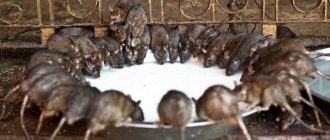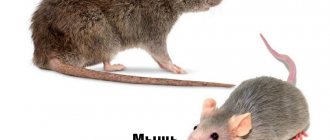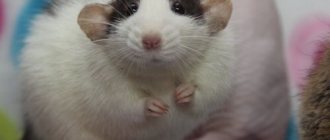Nobody knows when people first became acquainted with rats; this animal always lives next to us.
The rat belongs to the mammals, to the order - rodents, suborder - mouse-like. The most common animal on the planet is the rat.
Description of rats
Rats are the most common mammals of this family. They can be found anywhere on our vast Planet. Despite their belonging to the family, rats differ from mice not only in appearance, but also in their behavior. In addition, rats are much larger in size compared to mice. Their body is more developed, the muzzle is more elongated, and the nose is more elongated. The rat's eyes are relatively small, like beads.
In case of danger, these rodents begin to secrete a strong-smelling secretion, thanks to which the rest of the family becomes aware of the danger. Despite their size, their body structure is such that they are able to fit through small holes, which make up about 25 percent of the total body girth.
Appearance
These representatives of the mouse family have a body structure characteristic of rodents, which is quite powerful and oval in shape. Adults grow from 8 to 30 cm in length, while their weight can range from 40 to 510 grams. There are species that differ markedly from their counterparts, depending on species characteristics, as well as on their habitat.
The rat's muzzle is pointed and elongated, with small eyes and ears. In most varieties, the tail is completely naked, covered with scales and sparse hairs. Black rats are distinguished by the fact that their tail is completely covered with thick black hair. As a rule, rats have a rather long tail, the size of which is commensurate with the length of the body, and sometimes exceeds this indicator. Although it should be noted that there are also short-tailed rats.
The jaws of this rodent are armed with pairs of incisors, which are noticeably larger than the teeth. The molars are arranged in dense rows, which allows the rodent to quickly and actively grind food. Between the incisors and molars, you can observe an area where teeth do not grow. Rats do not have fangs, although they are omnivorous mammals. A rat's incisors are constantly growing, which requires constant grinding, otherwise the animal will not be able to fully close its mouth. This is due to the fact that the incisors do not have roots. The front part of the incisors is much stronger than the back part, since it is covered with durable enamel. As a result, the grinding of the incisors does not occur evenly, and over time they acquire a chisel-like shape. The teeth of these animals are so strong that the rat can easily cope with obstacles in the form of brick or concrete, although they were originally intended by nature to obtain exclusively plant food.
Interesting to know! Rats have a fairly thick and dense coat, thanks to well-defined guard hairs. The color of the coat can be different, both grayish-brown and dark gray, with the presence of various reddish, orange or yellow shades.
Although rats have calluses on their paws, they are poorly developed. Due to the presence of calluses, many animals move quickly on any surface. This deficiency in rats is compensated for by tenacious and mobile toes. Therefore, rats can lead both a terrestrial and semi-arboreal way of life. They easily move through trees, so they build their nests in tree hollows or use ready-made nests of other animals and birds, left by them for various reasons.
Behavior and lifestyle
Rats are considered incredibly agile living creatures and incredibly resilient. For animals of this size, they run well, picking up speeds of up to 10 km/h, while overcoming obstacles up to 1 meter high. These rodents travel an average of 12 kilometers every day. They are excellent swimmers and divers, so they can easily catch fish. Without harming their health, rats can stay in water for up to 3 days, or even more.
Burrows abandoned by other animals, as well as artificial shelters and nests of various birds can serve as a refuge for rodents. If necessary, the rat is able to dig a hole for itself on its own.
Rats can easily lead an isolated lifestyle or form family groups, as well as territorial communities. A colony may contain several hundred individuals, which are subordinate to one dominant male and several dominant females. Each such group is capable of controlling an area of about 2 thousand square meters.
Rats have poor vision, characterized by a small viewing angle of about 16 degrees, so the rat constantly rotates its head in different directions, studying the space around it. It is believed that rats perceive the surrounding space in gray tones, and continuous darkness appears as red.
Interesting fact! The rat has a well-developed sense of smell and hearing, so animals are able to hear sounds with a frequency of up to 40 kHz.
Rodents are capable of distinguishing odors at short distances. It should be noted that they can withstand radiation up to 300 roentgens per hour without any problems.
How long do rats live?
This indicator is directly related to species. If we take gray rats, then under natural conditions their average life expectancy is no more than one and a half years, although some individuals live up to 3 years.
If you take black rats, they live less than a year. When living in laboratories at various scientific institutions, rats live 2 times longer. The Guinness Book of Records contains information about the oldest rat, which managed to live for almost 8 years.
TOP 5 scary facts about rats
Sexual dimorphism
Upon reaching one and a half months of age, the animals’ sexual characteristics are fully formed. To determine whether it is a female or a male, it is enough to raise the tail to determine the structure of the animal’s reproductive system.
Males differ from females:
- By the presence of fairly large testicles, which can be detected if you lift the animal's tail.
- Males do not have nipples on their bellies like females. They are arranged in 2 rows.
- In males, the distance between the anus and the urethra is slightly greater.
- Males are stronger and more powerful, and they are also larger in size.
- Males have a pear-shaped body, while females have a graceful and elongated body shape.
- Males have denser and tougher fur, while females have smooth, soft and silky fur.
- Males are less aggressive than females.
- The urine of males has a sharper and more unpleasant odor.
As for newborn rat pups, it is almost impossible to determine their gender. Although experts know that males who have just been born have small spots between the anus and genitals. Over time, testicles appear in place of these spots.
Important point! According to experts, one pair of adult individuals in a couple of years is capable of producing offspring of up to 6 thousand cubs. Rats, having reached puberty, reproduce no less actively.
Difference between rats and mice
Rats and mice are representatives of the same suborder, but they differ significantly in appearance and behavior.
The body of a mouse is small, up to 20 cm, weighing up to 50 grams, rats are twice as large, they are dense and muscular, weighing up to 900 grams.
Pronounced distinctive shapes of the head and eyes, in mice it is triangular and slightly flattened with large eyes, in rats the muzzle is elongated with small eyes.
A strong body and powerful toes allow rats to jump high up to 1 meter; mice cannot do such tricks.
- Detailed description with photos of all animals included in the Red Book of Russia
Zebra - habitats, appearance, diet and behavior, life cycle + 94 photos
Leopard - habitats, life cycle, rutting season and lifespan + 118 photos
Mice are cowardly animals and are afraid to appear in front of people, but this does not bother rats; they can defend themselves. There are many cases where they attacked a person.
Rats are omnivores, eating meat and plant foods. On the contrary, mice have a greater preference for cereals and seeds.
Types of rats with photos and names
The genus “Rats” includes several dozen species that represent certain groups. Some of the species are considered extinct today.
Species groups include:
- Norvegicus;
- Rattus;
- Xanthurus;
- Leucopus;
- Fuscipes.
It makes sense to focus on the following types:
Gray rat, or Pasyuk (Rattus norvegicus)
It is considered the largest representative of this species. Pasyuki are found in quite numerous groups on the territory of Russia. The species was introduced accidentally, but is a true synanthrope. Pasyuki grow up to a maximum length of 25 cm, with a maximum weight of almost 400 grams. The tail is relatively short, the muzzle is wide and has a blunt ending. Juveniles are gray in color, and with age the coat acquires a noticeable reddish tint. The guard hairs are shiny and long. The belly is lighter in color.
Black rat (Rattus rattus)
It is slightly smaller in size compared to the gray rat. Its muzzle is narrower, its tail is longer and its ears are large and rounded at the end. Rats grow up to a maximum of 21 cm and weigh no more than 300 grams. The tail of these rodents is covered with thick hairs. The main color of the animal is black-brown with a greenish tint, which extends more to the back area. The sides of the rat are lighter, and the belly is dark gray or ashy. Some individuals have a color similar to the gray rat, but their back is lighter, yellowish in color.
Small rat (Rattus exulans)
This rodent belongs to a species that is also quite widespread. The species differs from other species in its small (comparatively) body size. The maximum length of the body is in the range of 11-14.5 cm, and the maximum weight averages 70 grams. This rodent has a compact body, a sharp muzzle, large ears and a brown coat.
Long-haired rat (Rattus villosissimus)
The name itself suggests that the rodent has long hair. In addition, this species has a high reproductive rate. Adults grow up to 19 cm in length, with a tail length of about 15 cm. The average weight of the animal is in the range of 120-150 grams, depending on gender.
Kinabuli rat (Rattus baluensis)
It belongs to a very unique species that has a symbiotic relationship with the tropical carnivorous plant "Nepenthes Raja". This rather large plant secretes a sweet secretion, which attracts the rat. In return, the rats leave their excrement for the plant.
Turkestan rat (Rattus pyctoris)
It is a typical inhabitant, which is distributed in countries such as Afghanistan, Nepal, China, India, Pakistan, Iran, Uzbekistan and Kyrgyzstan. Adults grow up to 17-23 cm and their tail length is almost equal to their body length. The animal's abdomen is yellowish-white, and the back area has a reddish-brown tint.
Silver-bellied rat (Rattus argentiventer)
This variety is not distinguished by its wide distribution on the planet. Its coat color is characterized as ocher-brown, with the presence of a small amount of black hairs. The belly is colored gray, while the sides are light and the tail is brown. The length of adult individuals can reach 40 cm or slightly more, weighing up to 200 grams maximum.
Furry-tailed rabbit rat (Conilurus penicillatus)
It has an average body size, reaching 22 cm. The animal weighs about 185 grams. Often in individuals the tail length is longer than the body length. A tuft of hairs grows at the end of the tail. The color of the dorsal part is grayish-brown, with black hairs. The hind legs and belly are almost white. The coat is quite hard and not very thick.
Soft-furred rat (Billardia meltada)
Refers to typical representatives living in countries such as Nepal, India, Sri Lanka, Bangladesh. The length of adult individuals is in the range of 90-190mm, while the length of the tail can be in the range of 70-180mm. The species is distinguished by the fact that it has soft and silky fur, grayish-brown on the back and white on the belly. The upper part of the tail is dark gray.
Tan Rat (Rattus adustus)
This species became known a little over 70 years ago and was classified as an exceptional species. As far as is known, the species received its name due to the exceptional color of its coat.
Interesting fact! Rodents communicate with each other using ultrasonic waves. Their hearts beat at a rate of 300-500 beats per minute.
5 Biggest Rats in the World
Differences between the cubs
Sometimes you can find a nest with babies, but it is difficult to make out who is who. It is necessary to pay attention to the following points:
- You can distinguish a mouse from a baby rat by the structure of its body. In adults it has more pronounced features. Rat cubs at two weeks of age reach the size of a large mouse, but are distinguished by underdeveloped features. High forehead, massive paws, long fingers, small ears.
- It is also easy to distinguish a mouse from a baby rat. Their body proportions resemble adults, but are not pronounced. Mice have large round ears, a blunt muzzle, and thin legs. The pups have a long muzzle, barely noticeable ears, massive paws, and a bare tail.
Mice and rat pups
Cubs differ in size. For comparison, baby rats are born with the same dimensions that the pups reach in a month.
Natural habitats
Rats can safely be called animals that appeared on earth even before man appeared on it. They are found in almost all corners of our Earth. Depending on the species, they are found both within the Euro-Asian continent and within other continents, including Australia, the Malay Archipelago, New Guinea, etc.
Yet their habitat is limited to northern, cold regions. Within central Russia there are no more than 2 species of rats - gray and black. If necessary, a rat can cover up to fifty kilometers in one day.
Rats are mammals that easily adapt to fairly difficult living conditions, which is why rats are often found at abandoned research stations in Antarctica.
Gray rat: habitat
In nature, these rodents settle only where there are sources of water, without which they cannot survive even three days. They prefer lowlands overgrown with vegetation, but can also climb mountains. They don't bother people at all. Only rats that live near humans are harmful. Some are permanent tenants, others are temporary, leaving in the spring to live freely and returning in the fall. They live in boiler rooms, basements, barns, and can live in high-rise buildings, but they rarely rise above the 9-10th floor.
In cities, rats have chosen sewer systems and subways, port docks and store warehouses. In villages, they live on livestock farms, poultry houses, and fruit and vegetable processing factories. One rat family controls a territory of up to 2 thousand m2, which all its members regularly mark with urine. In case of food shortage, rodents can expand the boundaries of their kingdom.
Rat diet
Rats are considered omnivorous rodents, but their diet depends on their living conditions, which is directly related to their lifestyle. Each animal needs about 25 grams of feed per day. At the same time, the lack of food is very difficult for animals to tolerate. As a rule, after three days, without food, the animal dies. The absence of water is even more difficult for animals. To maintain normal functioning, rats need to drink up to 35 ml of water per day.
The physiological characteristics of rats are that they are more adapted to the consumption of food items with a high protein content. Therefore, it is quite natural that they simply need animal food. Gray rats never prepare food for future use. The diet of black rats is mainly related to plant foods.
Black rats eat:
- Nuts and seeds of various plants.
- Chestnuts.
- Cereal grains.
- Fruits of various plants.
- All kinds of greens.
When rats settle not far from human habitation, they feed on any food they have access to. Those rats that live far from human habitation are able to feed on small rodents, mollusks, amphibians, bird eggs and their chicks. Those species that live on the coast feed on gifts from the seas and oceans washed ashore by waves.
Important point! Rats have an excellent sense of fullness, so they never overeat, even when very hungry.
From hatred to love one step
Long gone are the days when rats were considered enemies and were destroyed as carriers of plague. These rodents began to be domesticated in the 19th century and were used in fights against dogs, shown in the circus, and some daredevils kept them at home as curiosities.
In the twentieth century, rats were actively used by institutes and laboratories for experiments, and today the popularity of the animal as a pet is increasing.
With the help of selection, incredible results have been achieved: decorative rats are not at all similar to their wild “relatives” - they lack aggression, they do not try to avoid people...
At the same time, decorative rats have not lost their sharp mind and are able to pleasantly surprise with their antics and make the most ardent rat-haters touch.
Reproduction and offspring
Rats, regardless of species, reproduce at a very high rate. This is also due to the fact that they quickly reach puberty. Females bear their offspring over short periods of time. A sexually mature female can mate every 5 days, with the exception of the period of pregnancy.
Within 1 year, each adult female gives birth to up to 4 dozen rat pups, while pregnancy lasts about 3 weeks. Having reached the age of one and a half years, females are approaching the period of menopause, which at the initial stage appears irregularly, and then the female is no longer able to reproduce.
Before the end of the pregnancy period, the female tidies up her nest. She lines the bottom of the nest with soft grass. Sometimes the female digs a new hole, after which she takes care of its arrangement. Often in this nest the female contains food reserves, thanks to which she can stay with the newborns for a long time without any problems.
Depending on the species, female rodents can reproduce from 8 to 15 young at a time. Rats are born naked, blind and deaf, with completely closed ear canals, and without a well-functioning thermoregulation system.
After birth, they are not able to independently remove processed components. Therefore, the female constantly licks her stomach with it, as if giving a massage, which helps to activate metabolic processes. The cubs feed on mother's milk, the fat content of which reaches 9 percent. Unfortunately, rats are capable of destroying their offspring, and males are more prone to this. As for females, they can eat dead cubs or very weak ones.
Interesting to know! Domestic rats can mate with black rats, but their offspring do not survive, and quite often the mother's body completely rejects the embryos, and often non-viable offspring are born.
After some time, fur appears on the body of the rat pups, and after a week they begin to see and hear. On the ninth day, the first incisors erupt in the juveniles. After 3 weeks, the young offspring independently explore the nearby territory, and after another week they are ready for independent life. They become fully mature by the age of one year.
Achievements
The gray rat (pasyuk), if nothing threatens it, is very good-natured, busy only with getting food, and in search of it it can cover up to 20 km in a day. If she has to flee, she is able to reach a speed of 10 km/h, jump over an obstacle up to 2 m high, dive, swim more than 20 km. There are societies that organize rat Olympics, which include the so-called “pentathlon” - running, jumping, overcoming obstacles (climbing), lifting weights and tightrope walking.
A rodent can stay in water for up to 4 days. It likes the climate to be mild, but even in temperatures down to -18 °C it lives without any particular difficulties, and even reproduces. Confirmation of this is rat nests with live pups found in freezers, made in animal carcasses. They are also comfortable in boiler rooms, where the air temperature is about +45 °C. Rats do not die from radiation up to 300 roentgens/hour, and they are able to feel it with their nose.
Population and species status
Since the beginning of the third millennium, black rat populations have declined markedly and become fragmented. According to experts, black rats have begun to be replaced by more fertile gray rats (pasyuki). And yet, despite the high fertility, rat populations do not go beyond the “Red Line”, since their numbers are controlled by a number of important factors.
Firstly, the number of these animals directly depends on the availability of food and shelter. Lack of food immediately leads to a decline in population. In addition, there are special rat control services. The number of these animals is constantly declining as a result of certain diseases, as well as hunting by many predators. Therefore, despite their high fertility, which leads to constant surges in their numbers, natural factors, as well as rat control services, are doing their job.
Today, most species of rats are not even close to the risk zone, although there are very rare species that are protected. As a rule, the number of rare species largely depends on the life activity of people, who are developing more and more new territories that are related to the natural habitat of these species.
Franklin Island is home to a very rare species of “House Rats.” Due to the fact that the species lives in a limited area, it is classified as an endangered species. Currently, only about 2 thousand individuals live in this territory. Annual deforestation and fires can reduce kangaroo rat populations.
Varieties
There are several popular types and breeds of decorative rats:
- standard - a rat with smooth, glossy fur;
- Dambo - ears are larger than the others, rounded, low-set;
- satin - long wool, silky and shiny in appearance;
- sphinx - hair is completely absent;
- tailless - no tail;
- rex - much denser coat;
- double rex - hairless in some places, with rough fur in others;
- albino - a white decorative rat with red eyes.
Danger to humans
The confrontation between humans and rats has lasted for thousands of years. In our time, such a struggle has received an official name - rodent control. Despite its notoriety in Europe and many other countries, including the Americas, in some countries of the East this rodent received the status of a divine animal that symbolizes wealth, wisdom, prosperity, etc. The negative image of this rodent is associated with several plague epidemics in Europe, which were carried by rats.
Important point! Rats are involved in serious economic losses that are associated with spoilage and consumption of various types of goods, both food and other purposes. These rodents damage the insulation of electrical networks, which leads to fires that claim the lives of many people, not to mention damage to property.
Some species of rats cause serious damage to agricultural crops because they simply destroy crops. Therefore, in such conditions, people resort to various methods of protecting crops from rodent invasion. In some cases they are simply scared away, and in others they are physically destroyed. Currently, rats pose a serious threat to the health of all humanity, since these rodents carry pathogens of dangerous diseases. The danger of their vital activity also lies in the fact that these rodents are able to completely unnoticedly penetrate into a human home through sewage and ventilation systems.
Despite the constant and serious fight against rats and other rodents, it has not yet been possible to completely destroy them, but it is still possible to control the populations of these pests.
Experts have established certain norms for deratization, which is associated with the optimal percentage of freeing the territory from rodents.
Therefore it is considered:
- 80% – the result is satisfactory.
- 90% is a good result.
- 95% is an excellent result.
In this regard, it is generally accepted that the task of special deratization services is to maintain in a certain area an acceptable percentage of rodents that would not be able to cause much damage to human life.
Content Rules
Keeping decorative rats does not require any special wisdom. The main thing to do is to purchase a spacious cage.
Animals love to move, so they need space. The cage must be equipped:
- filler - the ideal option would be dry wood (it absorbs odors and liquids well);
- a house - a rat sometimes needs privacy;
- tunnels and ladders - pets will definitely want to play and run around;
- drinking bowl with fresh and clean water;
- a feeder well fixed to the rods;
- mineral stone so that animals can chew it.
It is strictly forbidden to use litter made from coniferous trees for decorative rats. It can cause serious illness and even death.
You can complement the design of the cage with various toys and treats for rodents.
Benefits and harms
It is believed that a small gray rat is capable of leaving a sixth of the world’s population without food (photos of rodents are presented in the article). An adult needs only 20 g of food per day, but over the course of a year this figure increases to 10-12 kg. If you remember that there are now almost 18 billion rats on the planet, you can imagine how much food they eat.
Rats can infect humans with such deadly diseases as plague, Q fever, typhus, as well as non-lethal, but also very dangerous helminths, staphylococci and streptococci.
These animals spoil things, furniture, leave houses and even entire villages without electricity, gnawing through electrical wiring.
And yet they bring us benefits that are difficult to overestimate. Geneticists have found that the genes of humans and gray rats have more in common than those of humans and monkeys. This makes it possible to carry out highly complex genetic research, which is also facilitated by the incredibly fast reproduction of rodents. Scientists are testing new medications on them, studying many deadly diseases in order to understand how to treat us humans. Therefore, rats deserve not only hatred, but also respect.
Life expectancy difference
Mice live very little in the wild and at home - their average lifespan is 1.5–2 years. Despite this, the colonies of these animals grow quite quickly, since rodents are able to give birth to offspring already at the age of 8–9 weeks. Moreover, additions to the family can occur up to 10 times a year.
You will be interested to know how many years decorative house mice live.
The lifespan of rats is longer - up to 3 years. They also become “parents” quite early, reproducing up to 12 members of the offspring at a time.
War of blacks and grays
Once upon a time, black rats reigned supreme in Europe. They were known about and destroyed back in the ancient period, and in the Middle Ages they even organized teams of professional rat catchers. Despite all efforts, in the 14th century, millions of people died from a plague carried by black rats.
They are smaller than gray ones, do not like to move long distances and live in basements, preferring to live in attics and roofs. Now in cities the gray rat is replacing the black one, since it turned out to be less intelligent and weaker. If there is enough food, the grays do not bother their black brothers and crowd them out only when there is a shortage of food. In settlements remote from the sea, for example in Moscow, there are very few black rats left, but in coastal cities their numbers are huge, and on ships they still dominate.
